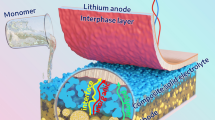Abstract
A simple and versatile method for preparation of hierarchical sodium bismuth sulfide (NaBiS2) nanostructures is developed via a simple solvothermal route. They were firstly tested as anode materials for sodium-ion battery. NaBiS2 is found to be characteristic of high capacity and low potential versus Na/Na+, which would be a promising anode material for sodium-ion battery. The NaBiS2 nanoparticles electrode delivers a second discharge capacity of 692.4 mA h g−1 at a current density of 10 mA g−1. A possible electrochemical reaction mechanism was proposed.






Similar content being viewed by others
References
Cheng FY, Liang J, Tao ZL et al (2011) Functional materials for rechargeable batteries. Adv Mater 23:1695–1715
Fei HL, Liu X, Lin YS et al (2014) Facile synthesis of ammonium vanadium oxide nanorods for Na-ion battery cathodes. J Colloid Interf Sci 428:73–77
Pan HL, Hu YS, Chen LQ (2013) Room-temperature stationary sodium-ion batteries for large-scale electric energy storage. Energy Environ Sci 6:2338–2360
Fei HL, Li H, Li ZW et al (2014) Facile synthesis of graphite nitrate-like ammonium vanadium bronzes and their graphene composites for sodium-ion battery cathodes. Dalton Trans 43:16522–16527
Ding J, Wang HL, Li Z et al (2014) Carbon nanosheet frameworks derived from peat moss as high performance sodium ion battery anodes. ACS Nano 12:11004–11015
Zhu HL, Jia Z, Chen YC et al (2013) Tin anode for sodium-ion batteries using natural wood fiber as a mechanical buffer and electrolyte reservoir. Nano Lett 13:3093–3100
Qian JF, Chen Y, Wu L et al (2012) High capacity Na-storage and superior cyclability of nanocomposite Sb/C anode for Na-ion batteries. Chem Commun 48:7070–7072
Li WJ, Chou SL, Wang JZ et al (2014) Sn4+xP3 @ Amorphous Sn-P composites as anodes for sodium-ion batteries with low cost, high capacity, long life, and superior rate capability. Adv Mater 26:4037–4042
Yu HJ, Ren Y, Xiao DD et al (2014) An ultrastable anode for long-life room-temperature sodium-ion batteries. Angew Chem Int Ed 53:8963–8969
Qian JF, Wu XY, Cao YL et al (2013) High capacity and rate capability of amorphous phosphorus for sodium ion batteries. Angew Chem Int Ed 52:4633–4636
Li WJ, Chou SL, Wang JZ et al (2013) Simply mixed commercial red phosphorus and carbon nanotube composite with exceptionally reversible sodium-ion storage. Nano Lett 13:5480–5484
Wang SW, Wang LJ, Zhu ZQ et al (2014) All organic sodium-ion batteries with Na4C8H2O6. Angew Chem Int Ed 126:5892–5896
Hu Z, Wang LX, Zhang K et al (2014) MoS2 nanoflowers with expanded interlayers as high-performance anodes for sodium-ion batteries. Angew Chem Int Ed 126:13008–13012
Zhou TF, Pang WK, Zhang CF et al (2014) Enhanced sodium-ion battery performance by structural phase transition from two-dimensional hexagonal-SnS2 to orthorhombic-SnS. ACS Nano 8:8323–8333
Yu DYW, Prikhodchenko PV, Mason CW et al (2013) High-capacity antimony sulphide nanoparticle-decorated graphene composite as anode for sodium-ion batteries. Nat Commun 4:2922–1
Qu BH, Ma CZ, Ji G (2014) Layered SnS2-reduced graphene oxide composite- a high-capacity, high-rate, and long-cycle life sodium-ion battery anode material. Adv Mater 26:3854–3859
Kanatzidis MG, McCarthy TJ, Tanzer TA et al (1996) Synthesis and thermoelectric properties of the new ternary bismuth sulfides KBi6.33S10 and K2Bi8S13. Chem Mater 8:1465–1474
Liao YH, Park KS, Xiao PH et al (2013) Sodium intercalation behavior of layered NaxNbS2 (0 < = x < = 1). Chem Mater 25:1699–1705
Zhang CL, Yin HH, Han M et al (2014) Two-dimensional tin selenide nanostructures for flexible all-solid-state supercapacitors. ACS Nano 8(4):3761–3770
Pang H, Wei CZ, Li XX et al (2014) Microwave-assisted synthesis of NiS2 nanostructures for supercapacitors and cocatalytic enhancing photocatalytic H2 production. Sci Rep 4:1–7
Du WM, Wang ZY, Zhu ZQ et al (2014) Facile synthesis and superior electrochemical performances of CoNi2S4/graphene nanocomposite suitable for supercapacitor electrodes. J Mater Chem A 2:9613–9619
Zhao Y, Liu TT, Xia H et al (2014) Branch-structured Bi2S3-CNT hybrids with improved lithium storage capability. J Mater Chem A 2:13854–13858
Zhao Y, Gao DL, Ni JF et al (2014) One-pot facile fabrication of carbon-coated Bi2S3 nanomeshes with efficient Li-storage capability. Nano Res 7:765–773
Kang SM, Hong YH, Jeon YJ (2014) A facile synthesis and characterization of sodium bismuth sulfide (NaBiS2) under hydrothermal condition. Bull Korean Chem Soc 35:1887–1890
Liu ZP, Peng S, Xie Q et al (2003) Large-scale synthesis of ultralong Bi2S3 nanoribbons via a solvothermal process. Adv Mater 15:936–940
Fei HL, Li ZW, Feng WJ et al (2014) Stable anode performance of vanadium oxide hydrate semi-microspheres and their graphene based composite microspheres in sodium-ion batteries. Dalton Trans 44:146–150
Acknowledgments
The project was supported by the National Natural Science Foundation of China (Grant No. 51204058), the fund (JA12037) from the Fujian Education Department, the open project in Key Lab Adv. Energy Mat. Chem. (Nankai University), and the State Scholarship Fund from the China Scholarship Council (CSC).
Author information
Authors and Affiliations
Corresponding author
Rights and permissions
About this article
Cite this article
Fei, H., Feng, Z. & Liu, X. Novel sodium bismuth sulfide nanostructures: a promising anode materials for sodium-ion batteries with high capacity. Ionics 21, 1967–1972 (2015). https://doi.org/10.1007/s11581-014-1356-0
Received:
Revised:
Accepted:
Published:
Issue Date:
DOI: https://doi.org/10.1007/s11581-014-1356-0




